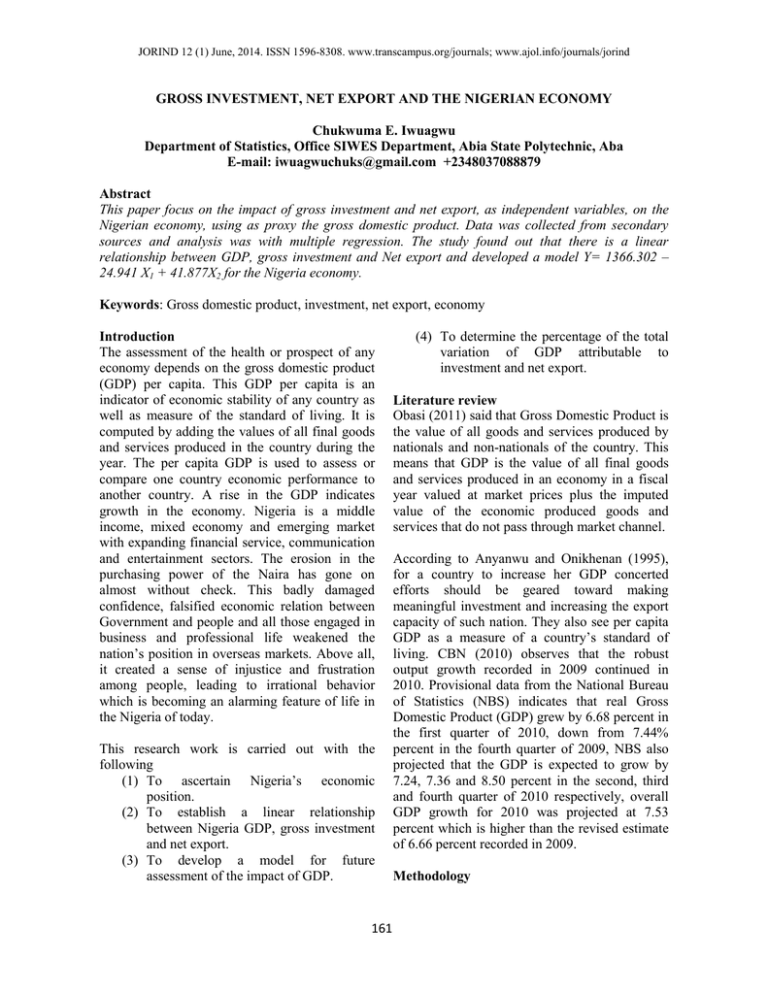Gross investment, net export and the Nigerian economy
advertisement

JORIND 12 (1) June, 2014. ISSN 1596-8308. www.transcampus.org/journals; www.ajol.info/journals/jorind GROSS INVESTMENT, NET EXPORT AND THE NIGERIAN ECONOMY Chukwuma E. Iwuagwu Department of Statistics, Office SIWES Department, Abia State Polytechnic, Aba E-mail: iwuagwuchuks@gmail.com +2348037088879 Abstract This paper focus on the impact of gross investment and net export, as independent variables, on the Nigerian economy, using as proxy the gross domestic product. Data was collected from secondary sources and analysis was with multiple regression. The study found out that there is a linear relationship between GDP, gross investment and Net export and developed a model Y= 1366.302 – 24.941 X1 + 41.877X2 for the Nigeria economy. Keywords: Gross domestic product, investment, net export, economy Introduction The assessment of the health or prospect of any economy depends on the gross domestic product (GDP) per capita. This GDP per capita is an indicator of economic stability of any country as well as measure of the standard of living. It is computed by adding the values of all final goods and services produced in the country during the year. The per capita GDP is used to assess or compare one country economic performance to another country. A rise in the GDP indicates growth in the economy. Nigeria is a middle income, mixed economy and emerging market with expanding financial service, communication and entertainment sectors. The erosion in the purchasing power of the Naira has gone on almost without check. This badly damaged confidence, falsified economic relation between Government and people and all those engaged in business and professional life weakened the nation’s position in overseas markets. Above all, it created a sense of injustice and frustration among people, leading to irrational behavior which is becoming an alarming feature of life in the Nigeria of today. This research work is carried out with the following (1) To ascertain Nigeria’s economic position. (2) To establish a linear relationship between Nigeria GDP, gross investment and net export. (3) To develop a model for future assessment of the impact of GDP. 161 (4) To determine the percentage of the total variation of GDP attributable to investment and net export. Literature review Obasi (2011) said that Gross Domestic Product is the value of all goods and services produced by nationals and non-nationals of the country. This means that GDP is the value of all final goods and services produced in an economy in a fiscal year valued at market prices plus the imputed value of the economic produced goods and services that do not pass through market channel. According to Anyanwu and Onikhenan (1995), for a country to increase her GDP concerted efforts should be geared toward making meaningful investment and increasing the export capacity of such nation. They also see per capita GDP as a measure of a country’s standard of living. CBN (2010) observes that the robust output growth recorded in 2009 continued in 2010. Provisional data from the National Bureau of Statistics (NBS) indicates that real Gross Domestic Product (GDP) grew by 6.68 percent in the first quarter of 2010, down from 7.44% percent in the fourth quarter of 2009, NBS also projected that the GDP is expected to grow by 7.24, 7.36 and 8.50 percent in the second, third and fourth quarter of 2010 respectively, overall GDP growth for 2010 was projected at 7.53 percent which is higher than the revised estimate of 6.66 percent recorded in 2009. Methodology JORIND 12 (1) June, 2014. ISSN 1596-8308. www.transcampus.org/journals; www.ajol.info/journals/jorind The data used in the analysis of this research was secondary and was collected from CIA world fact book. Multiple regressions were used in the analysis and this is a statistical technique used in determining the relationship among variables. It helps to provide adequate description of the process under study. The general linear regression model is given by Y1 = 0 + 1 11 2 12 K 1K The least squares normal for the general linear regression model are (X1 X) b = X1Y and the least squares estimators are b .1 1 1 The analysis of variance (ANOVA) result is given by S.V SS D.F MS F Regression SSR K-I MSR MSR F= MSE ERROR TOTAL SSE SST0 n-k n-1 MSE 1 n 1 SSR = b 1 1 1 111 n .Where SST0 = Y1Y - . 1 11 1 SSE = Y1 Y – b1 X1 Y Where Y = GDP per capita ($) X1 = Investment (Gross fixed) (%) X2 = Net Export ($) Data presentation Data was collected yearly on GDP, gross fixed investment and net export as stated below Year GDP per capita($) Investment gross fixed (%) Net export($) Y X1 X2 2003 900.00 27.70 3.70 2004 1000.00 18.0 7.26 2005 1400.00 21.30 16.85 2006 1500.00 26.40 26.21 2007 2100.00 23.70 33.91 2008 2300.00 21.70 31.31 2009 2300.00 9.70 30.27 2010 2500.00 11.60 42.15 2011 2600.00 13.80 30.84 2012 2700.00 18.80 26.88 Source: C/A world fact book. Data analysis To Test the linear relationship between GDP, investment and Net export. H0: There is no linear relationship between GDP investment and Net export. H1: There is linear relationship between GDP, investment and Net export From the data analyzed with SPSS the f cal = 12.864 while from the f –table the tabulated value at 5% level of significance is 4.74. Since F cal = 12.864 > 4.74 = f Tab, we reject H0 and conclude that there is a linear relationship between the variables that is GDP, investment and Net export. 162 JORIND 12 (1) June, 2014. ISSN 1596-8308. www.transcampus.org/journals; www.ajol.info/journals/jorind Model for Nigerian economy The estimated linear model is Y = b0 + b1X1 + b2 X2 Y = 1366.302 – 24.941X1 + 41.877X2 b1 = -24.941 is an estimate of the expected decrease in GDP corresponding to a decrease in percentage investment when net export is held constant. Similarly b2 = 241.887 means an estimate of the expected increase GDP corresponding to an increase net export when investment is held constant. Total variation explained From the computer print out the coefficient of determination r2 = 78.6%. Thus when the two independent variable populations are considered the variation in GDP is reduced by 78.6 percent. Findings The overall data analyzed in this study reveal the following: (a) From the multiple regression conducted the trend b1 = -24.941 indicated a decrease in GDP corresponding to a decrease in a percentage investment while b2 = 41.877 means an estimated increase in GDP corresponding to an increase in net export. (b) The correlation coefficient of 0.887 showed that there existed a positive relationship between GDP, investment and Net export. (c) From the f –test conducted, the hypothesis indicated that there exist a linear relationship between GDP, investment and net export. (d) Coefficient of determination (RSquare) = 0.786 0r 78.6% indicated percentage of the total variation of GDP due to investment and net export. net export, that is increase in these variables leads to increase in GDP. The study finds that Nigeria’s investment is declining as the coefficient shows negative trend. This result indicates the reason why there is unemployment scourge in the country as there is paucity of investment in industries where the youths can work. The net export showed a positive trend. The government is encouraged to maintain the pace and introduce more policies that will encourage export and reduce the level of importation. Recommendation The researcher recommends the following (1) The government should channel more funds into investment especially building of industries, and equipping them so that they can employ more Nigerians. (2) the transformation agenda should focus on investment and development of new technologies. References Anyanwu J C and Oaikhenan (1995), Modern macroeconomics in Nigeria Onitsha: Joanee Educational publishers Ltd. CBN (2010), Communigue No 70 of the Monetary policy committee meeting May 10-11 2010. Koutsoyiannis A. (2001), Theory of Econometrics: An Introductory Exposition of Econometric methods, Kudli: Replika Press Prt. Ltd Okafor J C and Obasi A (2011), Fundamental of Macroeconomics Hipluka additional press company. Conclusion From the analysis, it is concluded that there is a linear relationship between GDP, investment and 163



![[Type text] Comparative Economic Systems Geography United States](http://s2.studylib.net/store/data/017625502_1-b7487ca59fdc4660c66af29356ff98a6-300x300.png)

